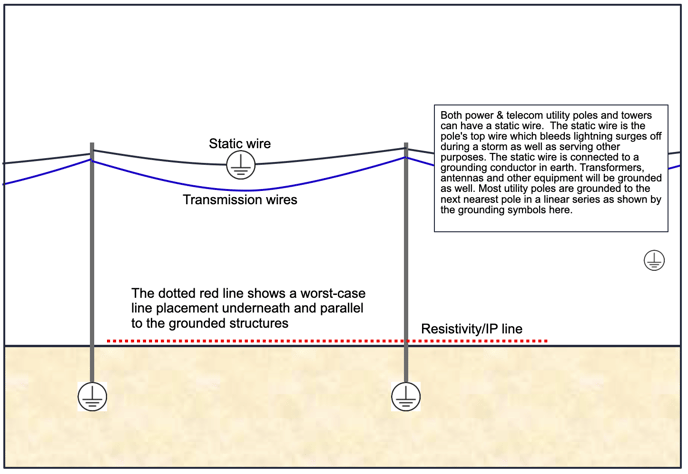Short Answer: There is a chance your results will be affected if the conductive object is grounded. Data anomalies also depend on your proximity to the conductive object and it's size.
Long Answer: Simply being conductive will not cause an issue. It is important to consider if the object is grounded well. Below are some common objects that may affect your results:
Fences
Linear conductive objects such as metal fences can affect surveys with an unaccounted pathway for the electricity to travel. A metallic fence isolated from the ground by a wooden post, will not affect results. And unlike many EM methods, a vehicle with rubber tires can be very close to a survey with no issues.
Possible interference can be tested by measuring the resistance from the metallic fence to the ground using your resistivity meter and an electrode stake. A simple 2 point test/contact resistance test mode can be used (V/I).
Wood fences will not introduce conductive pathways that could affect the survey. However, be aware that many older wooden post fences may have metal barb wire buried along the ground. Also, wood telecom and power poles will have a copper-clad base with a ground wire added for grounding and lightning protection.
Perpendicular or Parallel Objects (Such as fences, utility poles, or pipes)
Questions you should ask yourself before setting up a survey are "How close are these objects to the survey area?" and "Are these linear objects (fences and pipes) perpendicular or parallel to the survey line?". Measuring perpendicularly to a fence may only introduce a very shallow anomaly at the point of intersection. See the diagram below for more details.
Buried conductive objects
For example, buried drill stems from old oil wells can cause problems if an electrode stake is pounded into the ground and touches—or is very close (1 electrode spacing)—to the drill stem. The drill stem will effectively become part of the electrode stake. The inversion software will not take this new stake geometry into account without prior model parameters being added. Knowing the size, position and diameter of this now long electrode is required for proper modeling.
Example Water Pipeline
In some cases a pipeline is crossed over by chance or none of the options listed below are possible. In this example, the negative effects are minimized. A metallic water supply pipe sitting on a lake bed was crossed over with a submerged AGI marine cable in this case history. This is closest to the ideal Case 3 below. The region directly beneath the pipe and 15m from side to side is not reliable with the remainder of the line matching field observations. The object is minimized by crossing it perpendicular and also in the middle of the line where more unique measuring geometries are present. The red limestone contact and green weathered limestone contact are likely continues but obscured by the effects of this grounded metallic object. The pipe itself is smaller than the anomaly suggests. In general, grounded conductive metallic objects will resolve much larger in ERI models or will completely disrupt the surveys as would likely occur in case 1 below.
https://www.agiusa.com/mapping-bedrock-surfaces-near-lake-travis-texas
Worst (Case 1) Line Layout Parallel and In-between Grounded Utility Poles

All Grounded Metallic Infrastructure:
Worst Case (1), Better Case (2), and Best Case (3)

